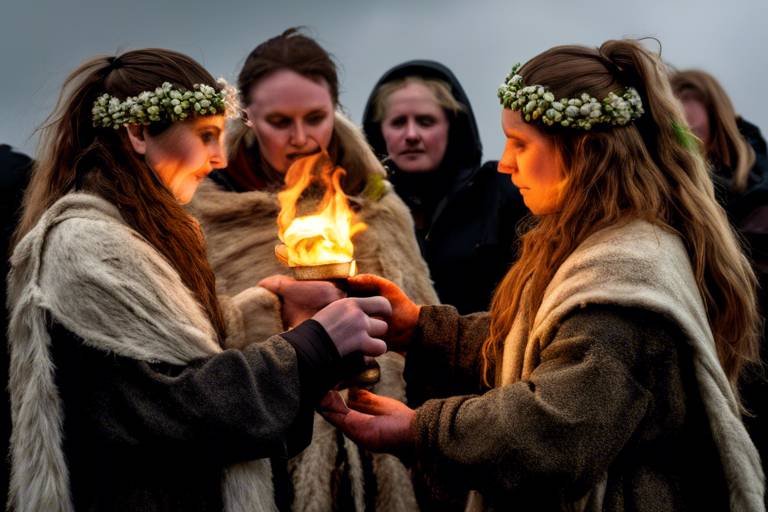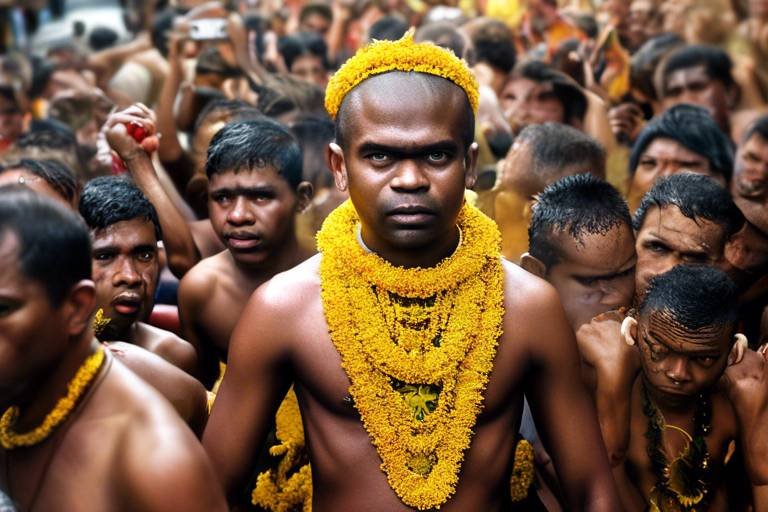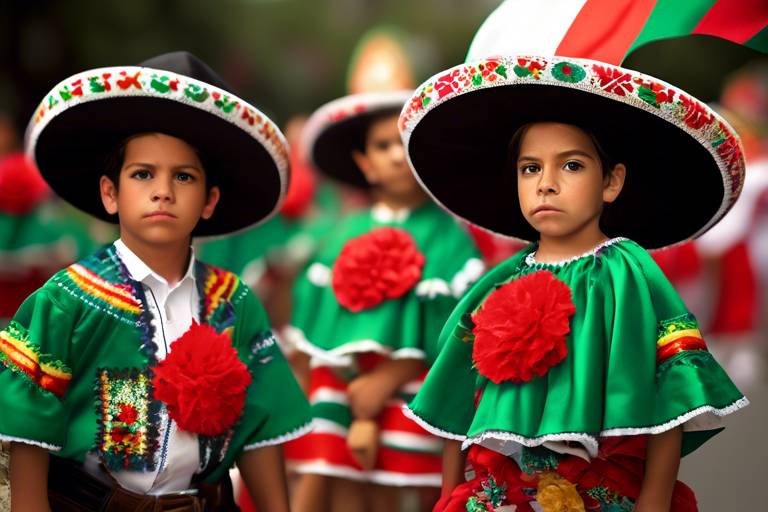Exploring Bali's Sacred Galungan Festival
Embark on a journey to uncover the mystical and enchanting world of Bali's Sacred Galungan Festival, a time-honored tradition that weaves together spirituality, culture, and community in a tapestry of vibrant celebrations and heartfelt rituals. As the island of Bali comes alive with the echoes of ancient beliefs and practices, the Galungan Festival stands as a testament to the enduring legacy of Balinese heritage.

History and Origins
The Galungan Festival in Bali holds a deep historical and cultural significance that dates back to ancient Balinese beliefs and practices. This vibrant celebration is rooted in the idea of dharma triumphing over adharma, symbolizing the eternal battle between good and evil. The festival honors the victory of virtue and righteousness, marking a time of spiritual renewal and connection with the divine.
Originating from the Balinese Hindu tradition, the Galungan Festival is a time when the island comes alive with colorful decorations, lively processions, and elaborate offerings. It is believed that during this period, ancestral spirits descend to visit their descendants, bringing blessings and guidance to the living. The festival serves as a bridge between the physical and spiritual realms, emphasizing the interconnectedness of all beings.
Throughout history, the Galungan Festival has been a symbol of Balinese identity and resilience in the face of external influences. Despite modernization and globalization, the Balinese people have preserved their cultural heritage and religious practices, passing them down through generations. The festival's origins lie in the ancient animistic beliefs of the island, which have evolved over time to incorporate Hindu teachings and rituals.

Preparations and Festive Atmosphere
Preparing for the Galungan Festival in Bali is a time of great excitement and meticulous attention to detail. As the festival approaches, the streets come alive with vibrant colors and bustling activities as locals engage in elaborate preparations to honor their ancestors and celebrate the victory of dharma over adharma. One of the most iconic preparations for Galungan is the decoration of penjor, tall bamboo poles adorned with offerings such as fruits, coconut leaves, and flowers, symbolizing gratitude and prosperity.
Walking through the streets of Bali during the lead-up to Galungan, one can feel the festive atmosphere permeating the air. The scent of incense wafts through the neighborhoods, and the sound of traditional music and laughter fills the surroundings. Families come together to create beautiful offerings known as gebogan, intricately arranged baskets filled with fruits, snacks, and flowers, showcasing the artistic and culinary skills of the Balinese people.
Amidst the preparations, the Balinese people also engage in spiritual practices to cleanse and purify themselves, ensuring that they are ready to welcome the ancestral spirits during the festival. Offerings are meticulously arranged on family altars and at temples, with each item symbolizing respect, gratitude, and devotion to the divine and ancestral beings believed to visit during Galungan.
As the festive atmosphere builds up, the sense of community and togetherness becomes palpable. Neighbors come together to help each other with preparations, sharing laughter and stories as they work side by side to create a harmonious and joyous environment for the upcoming celebrations. The unity and camaraderie that emerge during this time reflect the deep cultural values of the Balinese people.

Spiritual Significance
The of the Galungan Festival in Bali holds profound meaning for the Balinese people, rooted in their spiritual beliefs and practices. At the heart of this festival is the concept of ancestral spirits returning to the earthly realm to visit their living relatives. It is a time when the Balinese community comes together to honor and pay respects to their ancestors, seeking blessings and guidance for the future.
Central to the spiritual significance of Galungan is the idea of maintaining harmony and balance in the universe. Balinese Hindus believe in the constant struggle between good (dharma) and evil (adharma), and Galungan symbolizes the victory of dharma over adharma. Through prayers, offerings, and rituals, the Balinese seek to uphold this balance and ensure the well-being of their families and communities.
During Galungan, families prepare elaborate offerings known as 'banten' to present at temples and family shrines. These offerings typically include fruits, flowers, and symbolic items that hold spiritual significance. The act of making and presenting these offerings is a form of devotion and gratitude towards the divine and ancestral spirits, believed to bring blessings, protection, and prosperity.
Moreover, the Galungan Festival serves as a reminder of the interconnectedness between the physical and spiritual worlds. It is a time for introspection, reflection, and spiritual renewal, encouraging individuals to seek inner peace and connection with the divine. Through ceremonies, prayers, and acts of devotion, the Balinese reaffirm their faith and commitment to their spiritual beliefs, fostering a sense of unity and reverence within the community.

Traditional Ceremonies and Practices
Traditional ceremonies and practices during the Galungan Festival are deeply rooted in Balinese culture and spirituality. One of the most significant rituals is the temple visits, where families gather at local temples to offer prayers and blessings. These visits symbolize the community's unity and devotion to their faith, creating a sacred ambiance filled with incense and chants.
Another essential aspect of the festival is the making of colorful offerings. Balinese people meticulously craft intricate offerings known as "canang sari" using palm leaves, flowers, and various symbolic items. These offerings are placed in homes, temples, and shrines as a sign of gratitude and respect to the gods and ancestors, seeking blessings and protection for the community.
During Galungan, prayers play a central role in connecting individuals with the spiritual realm. Families gather to recite mantras and seek guidance from the divine, reinforcing their beliefs in the power of prayer to bring harmony and prosperity. The melodious sounds of traditional Balinese music and the rhythmic movements of dancers add a mystical touch to the ceremonies, enhancing the spiritual experience.
Moreover, the symbolic meaning behind these ceremonies and practices is profound. Each offering, prayer, and ritual is a symbolic gesture of gratitude, love, and devotion to the gods and ancestors. The Balinese believe that by honoring the divine beings and spirits, they maintain a harmonious relationship with the spiritual world, ensuring blessings and protection for themselves and their loved ones.

Community Involvement and Unity
Community involvement and unity are at the heart of the Galungan Festival in Bali. This sacred celebration not only honors the spiritual beliefs of the Balinese people but also serves as a unifying force that brings communities together in a shared sense of purpose and tradition. During Galungan, neighbors collaborate to create intricate offerings, decorate temples, and participate in various ceremonies that strengthen the bonds between individuals and families.
One of the most striking aspects of community involvement during Galungan is the collective effort that goes into preparing for the festival. Families work together to craft beautiful penjor, bamboo poles adorned with colorful decorations, symbolizing gratitude and prosperity. This communal activity not only beautifies the streets but also fosters a sense of camaraderie and shared responsibility among neighbors.
Moreover, the spirit of unity is palpable during Galungan as people come together to pray, make offerings, and visit temples as a community. The shared experience of engaging in traditional rituals and practices creates a sense of belonging and solidarity, reinforcing the cultural identity of the Balinese people and strengthening social bonds that transcend individual differences.
Through their active participation in the Galungan Festival, communities in Bali demonstrate the power of collective action and collaboration in preserving their cultural heritage and promoting harmony among diverse groups. This annual celebration serves as a reminder of the importance of coming together as a community to celebrate shared values and beliefs, fostering a sense of unity that transcends individual interests and promotes a deeper connection with one another.

Culinary Delights and Festive Feasts
Delve into the culinary aspects of the Galungan Festival, where traditional Balinese dishes take center stage, offering a feast for both the palate and the senses. The festival is a time when families and communities come together to prepare and enjoy an array of delicious delicacies that hold special significance during this auspicious occasion. From savory dishes like Lawar (a traditional minced meat salad) and Babi Guling (suckling pig) to sweet treats such as Jaja Laklak (coconut pancakes), the festival is a celebration of Balinese culinary heritage.
During Galungan, Balinese households are filled with the aromas of spices and cooking, as elaborate feasts are prepared to honor both the gods and ancestors. The dining table becomes a sacred space, adorned with offerings and dishes symbolizing abundance, prosperity, and gratitude. It's a time when food becomes a form of reverence, connecting the present with the past and the spiritual with the physical.
One of the most iconic culinary traditions during Galungan is the preparation of colorful offerings known as 'Banten'. These intricate arrangements of fruits, flowers, and rice cakes are meticulously crafted to please the eyes as well as the spirits. Each element of the offering carries symbolic meaning, representing different aspects of Balinese cosmology and beliefs.
As families gather around the dining table to partake in the festive feasts, the atmosphere is filled with laughter, chatter, and the clinking of utensils. Sharing food is not just a physical act but a spiritual one, symbolizing unity, generosity, and the interconnectedness of all beings. The culinary delights of Galungan not only satisfy hunger but also nourish the soul, creating a sense of communal joy and gratitude.

Symbolism in Offerings
During the Galungan Festival in Bali, offerings play a significant role in the spiritual and cultural practices of the celebration. These offerings, known as "banten," are meticulously crafted with various items that hold symbolic meanings deeply rooted in Balinese beliefs and traditions.
One of the essential elements of these offerings is fruits, symbolizing prosperity, abundance, and gratitude towards the gods for the bountiful harvest. The choice of fruits is not random; each fruit carries specific symbolism, such as bananas representing fertility and coconuts symbolizing resilience and protection.
Additionally, flowers are commonly used in the offerings to symbolize beauty, purity, and devotion. Balinese people believe that the fragrance of flowers attracts the spirits of their ancestors and gods, creating a harmonious atmosphere during the festival.
Moreover, rice holds a crucial symbolic meaning in Balinese culture, representing sustenance, life, and prosperity. The intricate arrangements of rice grains in the offerings reflect the Balinese people's respect for the cycle of life and their interconnectedness with nature.
Furthermore, incense is an essential component of the offerings, symbolizing purification and the connection between the physical and spiritual realms. The smoke from the incense is believed to carry prayers and blessings to the divine beings, creating a sacred ambiance during the festival.
Overall, the symbolism in the offerings during the Galungan Festival reflects the Balinese people's deep-rooted spiritual beliefs, their reverence for nature, and their desire to maintain harmony and balance in the universe through these symbolic gestures of gratitude and devotion.

Impact on Tourism and Cultural Exchange
When it comes to the impact of the Galungan Festival on tourism and cultural exchange, it's evident that this vibrant celebration plays a significant role in attracting visitors from all corners of the globe to Bali. The unique cultural experience offered by the festival, with its colorful ceremonies and rich spiritual traditions, has become a major draw for tourists seeking to immerse themselves in Balinese culture.
As tourists flock to Bali during the Galungan Festival, they not only witness the local customs and rituals but also actively participate in the festivities, creating a meaningful cultural exchange between visitors and the Balinese community. This exchange of ideas and traditions fosters a deeper understanding and appreciation of Balinese culture, strengthening cultural ties and promoting global harmony.
Moreover, the influx of tourists during the Galungan Festival has a positive impact on the local economy, boosting businesses such as restaurants, hotels, and souvenir shops. The increased tourism revenue benefits the community by providing economic opportunities and supporting local livelihoods, contributing to the overall prosperity of the region.
From a broader perspective, the Galungan Festival serves as a platform for cultural diplomacy, showcasing Bali's unique heritage and traditions to the world. Through cultural exchanges and interactions with tourists, the Balinese people have the opportunity to share their values, beliefs, and way of life, fostering mutual respect and understanding among diverse cultures.
Frequently Asked Questions
- What is the significance of the Galungan Festival in Bali?
The Galungan Festival in Bali holds great cultural and spiritual significance as it commemorates the victory of dharma over adharma and serves as a time to honor ancestors through vibrant ceremonies and offerings.
- How do locals prepare for the Galungan Festival?
Locals prepare for the Galungan Festival by decorating penjor (bamboo poles), creating elaborate offerings, and immersing themselves in the festive atmosphere that fills the streets of Bali with joy and celebration.
- What are some traditional ceremonies and practices associated with Galungan?
Traditional ceremonies and practices during Galungan include temple visits, prayers, and the making of colorful offerings to honor ancestral and divine spirits, all aimed at maintaining harmony and balance in the universe.
- How does the Galungan Festival impact tourism and cultural exchange in Bali?
The Galungan Festival has become a popular tourist attraction, drawing visitors from around the world who seek to witness and participate in the cultural event, contributing to the exchange of ideas and traditions among diverse communities.



















